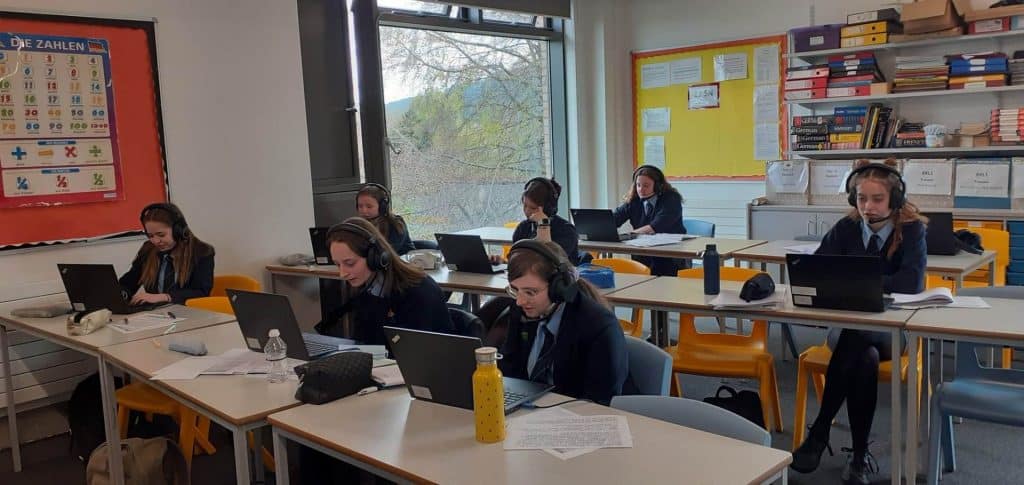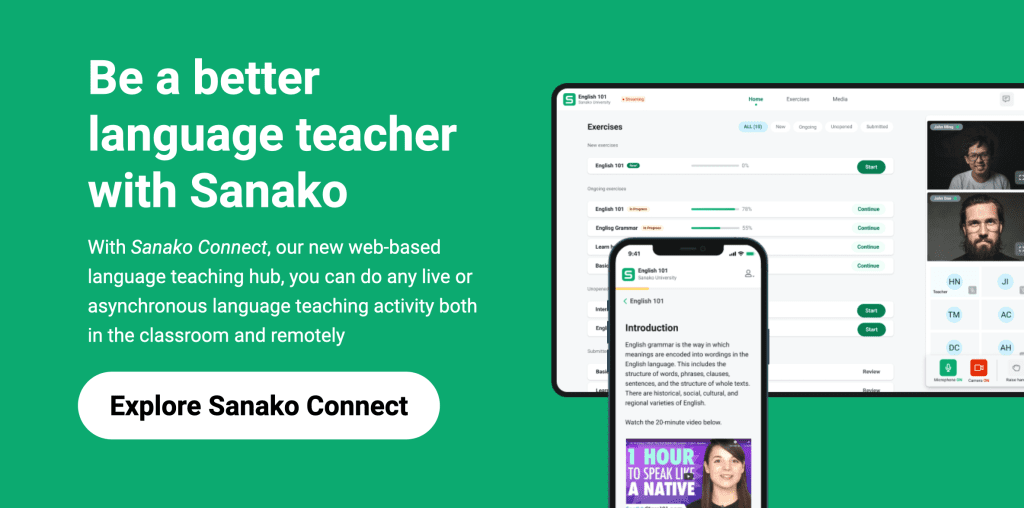Effective and impactful language learning is, ultimately, all about language production. It’s the best way to build students’ confidence and to demonstrate how their skills can be used in real-world scenarios. The onus is therefore on teachers to maximise opportunities for students to practise their core listening and speaking skills. Working in pairs or in groups is a great way to do this and helps get all students active and involved. Group-based activities also help develop other key skills including creativity, problem-solving and team working.
This blog post considers why pair and group activities are so important for language learning, explores how they can be most effective in the classroom and includes some suggestions for educators to try out in their daily practice.
To be completely clear, we’ll use the word “group” throughout this post. This can, of course, refer to students working in pairs or in larger units up to and including the whole class. The same principles still apply and can be scaled up or down depending on numbers.
Why are group activities so effective?
Modern language teaching is no longer just about “the sage on the stage”, conveying information to learners for them to learn. Today’s focus is all about creating an immersive learning experience in which students learn by doing. Pair and group activities excel at creating opportunities for language production because they:
- Enhance communication skills: Group activities encourage (force?) students to speak and interact with each other. They therefore promote active participation, ensuring that every student is involved. This exposure helps students to develop their core language skills, particularly listening and speaking.
- Feature real-life scenarios: Group activities deliberately simulate real-life language use, making learning more practical and relevant to students.
- Boost confidence: Students usually feel more comfortable practising and talking in pairs or small groups rather than standing in front of the class on their own. This encourages everyone to get involved and careful pairing can help even the most anxious students feel more confident.
- Cover different viewpoints: Students are encouraged to play different roles and to present different positions. This helps learners consider different perspectives, which enriches the discussions and broadens their understanding.
What are different types of group activities?
The honest answer to this question is that there is an infinite number of different types of group activities – it’s just limited by your imagination and classroom circumstances. However, they do tend to cluster around a few common themes.
Perhaps the most common and frequently used is role playing, where students are placed in a fictional, but real-world scenario. Each student is given a specific role to play, such as customer / waiter in a restaurant or boss / prospective employee in a job interview (see our previous blog post on role play for further inspiration).
Another example of a popular group activity would be a collaborative project. In this case, groups of students are given a task (e.g creating a travel brochure or producing a short film on a topic). Students work as a team to complete and present the task, assigning themselves roles and agreeing work schedules. Depending on their competence, some or all of this task is conducted in their L2.
A key element of such tasks is getting students to discuss and debate the right approach to tackling the task. This can, of course, be extended by getting groups of students to share their opinions on thought-provoking topics, news or current events.
Creative tasks are also popular for group-based activities. This includes story building exercises, where each student in a group contributes a sentence or a minute of film, for example, to collectively create / tell a story. As well as improving language skills, these exercises can also help develop students’ creativity and storytelling abilities.
Finally, consider setting students problem-solving challenges as your next group activity. Give the group a range of challenging language-related puzzles to work through together and solve.
Examples of these approaches can be found below.
How to run effective group activities in the classroom?
Oxford University Press recently published a useful guide to help students work effectively in pairs or groups. Although aimed at younger students, we think it provides a brilliant acrostic (“BE STARS”) for all learners to follow.
We’ve added our interpretation of their key principles below.
Be focused: Help students to maintain their concentration during group activities. Stress the importance of staying on task and avoiding distractions to maximise the learning experience for themselves and others.
Explain your ideas: Students should always be prepared to offer an explanation of their opinions and positions. Ensure that they use the target language to articulate their ideas clearly.
Share: Emphasise the importance of sharing responsibilities within the group. Encourage students to divide tasks and distribute work equitably, ensuring everyone participates actively and equally.
Take turns: It’s important for students to understand the value of patience and fairness in group dynamics. Show them how to take turns in speaking and listening, creating an inclusive environment where everyone’s voice is heard.
Ask questions: Try to foster a culture of curiosity by prompting students to ask questions within their groups. Encourage them to seek clarification, share concerns and engage in meaningful discussions.
Respect each other’s ideas: Promote an atmosphere of mutual respect by teaching students to appreciate diverse perspectives. Remember that differences in opinion can enrich discussions and lead to better learning outcomes.
Stay together: Stress the importance of teamwork and unity within groups. Encourage students to support each other, collaborate effectively, and ensure that no one is left behind in the learning process.
Possible group activity ideas
Given the above principles, here are 4 outline ideas for group activities that you could structure a lesson around and carefully tailor to your students and broader objectives.
1. Planning a dream vacation
Guidelines: Groups design a travel itinerary for a specific destination, considering budget, activities and cultural experiences.
What students do: Present their itinerary, explaining their choices and using persuasive language to engage their audience.
2. Solving language mysteries
Guidelines: Each group receives a set of coded messages in a foreign language. They must decipher and translate the messages to uncover a hidden story.
What students do: Share their findings and translations, promoting language decoding skills. They then present their answer, method and conclusions.
3. Solving language-related puzzles
Guidelines: Groups are “locked” in a virtual escape room with language puzzles to solve. This can include word scrambles, riddles, and decoding exercises.
What students do: They work together to solve the puzzles and “escape” within a specified time, using language skills to decipher clues and find the answers.
4. Reporting on current events
Guidelines: Each group becomes a news team responsible for presenting a news segment in the target language. Students have roles including anchor, reporter, subject experts etc.
What students do: They work collaboratively to create a news script, gather information, and then deliver a news broadcast to the class.
How Sanako Connect can be used to deliver group activities?
Modern EdTech tools like Sanako Connect offer a dedicated, online teaching platform that has also been specifically designed to help language educators facilitate live pair and group-based speaking activities in both physical or online settings. Sanako Connect for example enables language teachers to:
- Easily divide students into pairs or small groups for group activities or conversation practice. This takes place live online, so each group of students can talk simultaneously without distracting other groups.
- Listen in or talk with different groups to assist as required. All conversations can be easily recorded and reviewed for feedback after the event, rather than interrupting live conversations.
- Share engaging resources to support the live activities and provide context. This could include a wide variety of authentic real world materials including sound files, images, presentations, videos, virtual maps, or basically any other digital content.
- Provide detailed feedback via Connect’s two-track feedback functionality. Students can immediately see where improvements need to be made. They can then relisten to the original audio material and record additional attempts.
Click the banner below to find out more about how Sanako’s language teaching products could help improve your students’ speaking skills!


